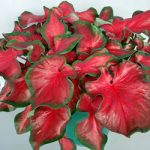
Heather N. Kolich, ANR Agent, UGA Extension Forsyth County
Beautiful poinsettias have a long history as a traditional Christmas plant. Unfortunately, as soon as I bring a poinsettia home, it starts dropping leaves. I was, therefore, very excited when I came across an item in a horticulture trade journal about using caladiums along with – or instead of – traditional poinsettias.
Colorful foliage is the ‘wow’ factor for caladiums. The big, heart-shaped leaves display a variety of colors – white, silver, green, pink, and red – in patterns from subtle to striking. A reliable stand-out for shade gardens, some newer cultivars tolerate more sun exposure.
Like poinsettias, caladiums are native to a much warmer climate. In Georgia, caladiums must wait until after the last frost in spring for outdoor planting, and the tubers should be dug up in the fall and stored in a dry, warm place (above 60 degrees Fahrenheit) during the winter. But, like many other tropical plants, caladiums make beautiful houseplants.
Playing the houseplant angle as a way to extend the season of signature caladium line ‘Heart to Heart,’ in 2020, national plant retailer and breeder Proven Winners approached two nurseries to experiment with growing caladiums in their greenhouses for the Christmas décor season. The results were positive, and this summer, caladiums earned a showcase spot in Christmas plant displays at Cultivate, a top green industry trade show and education event.

Caladiums offer some advantages over poinsettias for living holiday decorations. They are less fussy about overwatering and less prone to leaf drop. Caladiums can last in the house through Valentine’s Day before entering dormancy. Color is bred into caladiums, so it will reliably return year after year when regrown from the tuber, without complicated light and dark treatments. As houseplants, caladiums require medium to bright light, good soil moisture, and humidity. Protect them from heat registers and cold drafts.
Some things remain the same, regardless of whether your holiday plants are caladiums, poinsettias, or amaryllis. They still need to be kept out of reach of pets and children; they are toxic if eaten and the sap may cause skin irritation. Provide light and water according to the specific plant’s needs. Remove the decorative foil sleeve entirely or during watering to allow excess water to drain away from plant roots.
When caladium leaves begin to lose color, it’s time to prepare the tuber for a few months of rest. Reduce watering and allow the soil media to gradually dry out. Caladium tubers can be kept in the pot for dormancy. Clip dried leaves at soil level and remove them from the pot. Store the pots in a warm location (above 60 degrees) for 4-5 months, then move them to a bright location and begin watering again.
To preserve landscape planted caladiums for another season, dig up the tubers in the fall before temperatures drop below 55-60 degrees. Gently clean soil from the tubers and spread the plants out in a warm, bright location and leave them for 7-10 days to dry. Pull dried leaves from the dried tubers and remove any remaining soil with a soft brush. Store tubers packed in dry peat moss in a labeled paper bag in a warm, dry place. Plant in the landscape – or in outdoor pots – in May when soil temperatures are 70 degrees or higher and all danger of frost has passed.
Coming in 2023: Garden and Landscape Workshops (cost and registration information coming soon, visit our Forsyth County website for the latest information.)
Spring Gardening and Seed Starting Workshop – February 15, 2023, 10 a.m.-noon
Growing Food in Small Spaces Workshop – February 22, 2023, 10 a.m.-noon
Small Orchard Management and Pruning Workshop – March 1, 2023, 10 a.m.-noon
Rain Harvesting and Rain Barrel Workshop – Two dates:
February 11, 2023, 10-11:30 a.m.
March 16, 2023, 2-3:30 p.m.